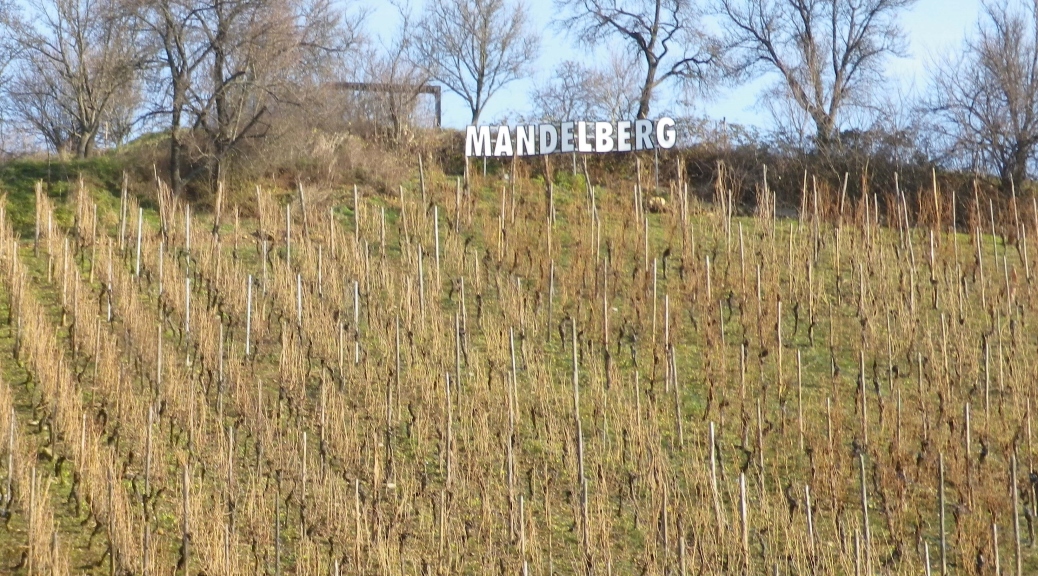What I Learned:
Alsace is a fantastic wine country. Alsace’s Haut-Rhin (upper Rhine) area is particularly favored with great terroirs, such as the Mandelberg displayed above. Here, as elsewhere in Alsace, the harvests are primarily white varietals. The soil here is minerally, and complex, resulting in crisp, refreshing and uniquely flavored white wines. The six main white varietals grown in Alsace are Riesling, Sylvaner, Muscat, Gewürztraminer, Pinot Blanc, and Pinot Gris. The only red varietal is Pinot Noir.
Visiting Alsace practically mandates you taste some local wine. First, you will notice the unusually tall wine bottles. You will also notice green-stemmed stemware, with smaller than usual bowls. These two unique items have more in common with German Rhineland traditions than French ones. But like the French tradition, wine producers proudly offer tastes of their product, for wine-making here is an art, and even nowadays, still a family affair.
My advice would be to try a Gewürztraminer and a Riesling, if nothing else. Gewürztraminer wine is usually quite aromatic. Tasting a good vintage can truly be a memorable experience, something you will always remember. Also, even if you haven’t particularly enjoyed Rieslings before, try them here, and you might change your mind!
The dry, delicious sparkling wines produced here are called “Cremant.” They are great blends of the white varietals grown in the region. Occasionally, Pinot Noir will be used in the blends and to produce a Rose. Alsatian cremants tend to be dry, light and refreshing. The best of these wines will bear the Appellation Cremant d’Alsace Controlee labels.
Alsatian wine classifications are similar to that of Burgundy with Grands Crus at the top of the quality spectrum, and AOC for just about everything else within specific areas.
What I Tasted:
2011 Gewürztraminer, Grand Cru Sonnenglanz, Heimberger, Cave de Beblenheim. A dry white wine reminiscent of a perfumed garden, filled with scents of rose and lavender, and a rich mouthfeel. Not subtle, but an amazing taste experience.
2011 Riesling, Grand Cru Sonnenglanz, Heimberger, Cave de Beblenheim: a dry white wine with slight floral notes, and just hints of minerality and slightly tart apple. Long floral finish and velvety-soft mouthfeel.
2010 Riesling, Grand Cru Kirchberg de Ribeauville, Jean Sipp: a dry white wine, refreshingly tart, hints of grapefruit, and other citrus.
2009 Riesling, Grand Cru Kirchberg de Ribeauville, Jean Sipp: A smooth, refreshing, slightly minerally Riesling with very mild acidity, and not at all tart.
2009 Riesling, Grand Cru Schoenenbourg, Earl Regine Zimmer, a dry white wine with rich medium gold color; tasting of melon and honey, with a hint of freshly cut grass. It had a medium mouthfeel. Smoky, spicy, with layers of flavors as it goes down.
Cremant Brut, Cuvee Julienne, Appellation Cremant d’Alsace Controlee, Dopff au Moulin: a dry sparkling wine with small bubbles and pale gold color; a blend of Pinot Blanc and Auxerrois, with light floral notes, and a light to medium body.
Cremant Brut, Appellation Cremant d’Alsace Controlee, Wolfberger: a dry sparkling wine composed of Chardonnay, Pinot Blanc and Riesling, with fine, spiraling bubbles, and with a light gold color; hints of vanilla, floral and stone fruits, very well-balanced, and very mild acidity
Cremant Brut, Cuvee Prestige St. Leon IX, Appellation Cremant d’Alsace Controlee, Wolfberger: a dry white sparkling wine composed of Pinot Blanc, Pinot Noir and Riesling, with medium gold color; floral and bready notes; very mild acidity.
Cremant Rose Brut, Appellation Cremant d’Alsace Controlee, Wolfberger: a dry rose sparkling wine, fine, swirling bubbles, salmon color; very smooth, with slight flavors of red berry fruits, with notes of wood and toast, and hints of slight tannins.
